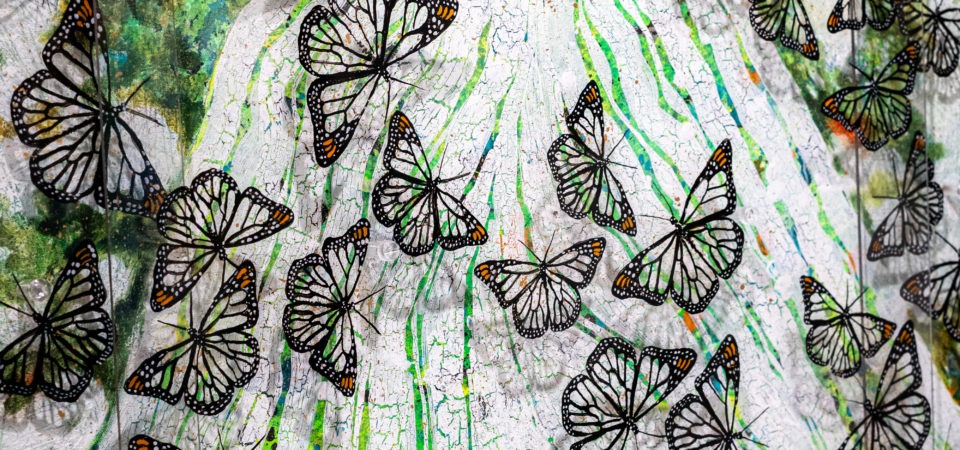Kathleen Kane-Murrell, La Ultima, mixed media, 60” x 48” (detail)
This article is published on the MAHB Blog and the MAHB Arts Community page.
2020 shook our world, forever altering our feelings of safety and stability. Who would have imagined that a global plague would force us to spend a year isolated in our homes, working remotely, wearing masks and sanitizing everything? Reluctantly we Zoomed along. Social media served as a tether to friends and family; meanwhile, art galleries and museums pivoted to a virtual presence.
I’m a professor and curator. The COVID pandemic forced me to quickly shift to an existence of bytes on a computer screen. Many of my students were essential workers and sacrificed themselves caring for the elderly, laboring in grocery stores or delivering goods. Illness and death entered our lives. It was an annus horribilis of challenges and change.
Entrance to the galleries with Bronle Crosby, Stronger Together, diptych, oil and charcoal on canvas, 72” x 96”
Left: Manuelita Brown, Uphill Struggle, bronze with wood base, 16.5” x 14.25” x 9”
Back in the summer of 2019 I was invited by Oceanside Museum of Art to curate the exhibition Twenty Women Artists: NOW. Artist Julia C R Gray conceptualized the project—artists reflecting on their experience as women, in the moment, in the present, in the knowingness of the NOW. TWA is a tight-knit collective of female artists in San Diego, skilled in in different media, who care and support each other. I was thrilled to offer my perspective as someone interested in art as social critique. I had organized the risk-taking unDocumenta at the museum as part of the Getty’s PST: LA/LA (2017) and in which artist Marcos Ramirez ERRE erected a rusted metal “border wall” temporarily obliterating the modern façade of the arts institution.
When we envisioned TWA: NOW we never thought that 2020 would become one of the most turbulent and tragic years in recent history or that women would be on the frontlines of many struggles. As COVID-19 spread swiftly around the globe and Southern California shut down, we were forced to make major adjustments. Our planned in person studio visits had to be orchestrated through Zoom. As a curator I look forward to sitting with an artist, walking around their studio and absorbing their creations—it is energizing. All of this was impossible during quarantine, but to our surprise, far from making our interactions impersonal our virtual conversations were open and heartfelt.
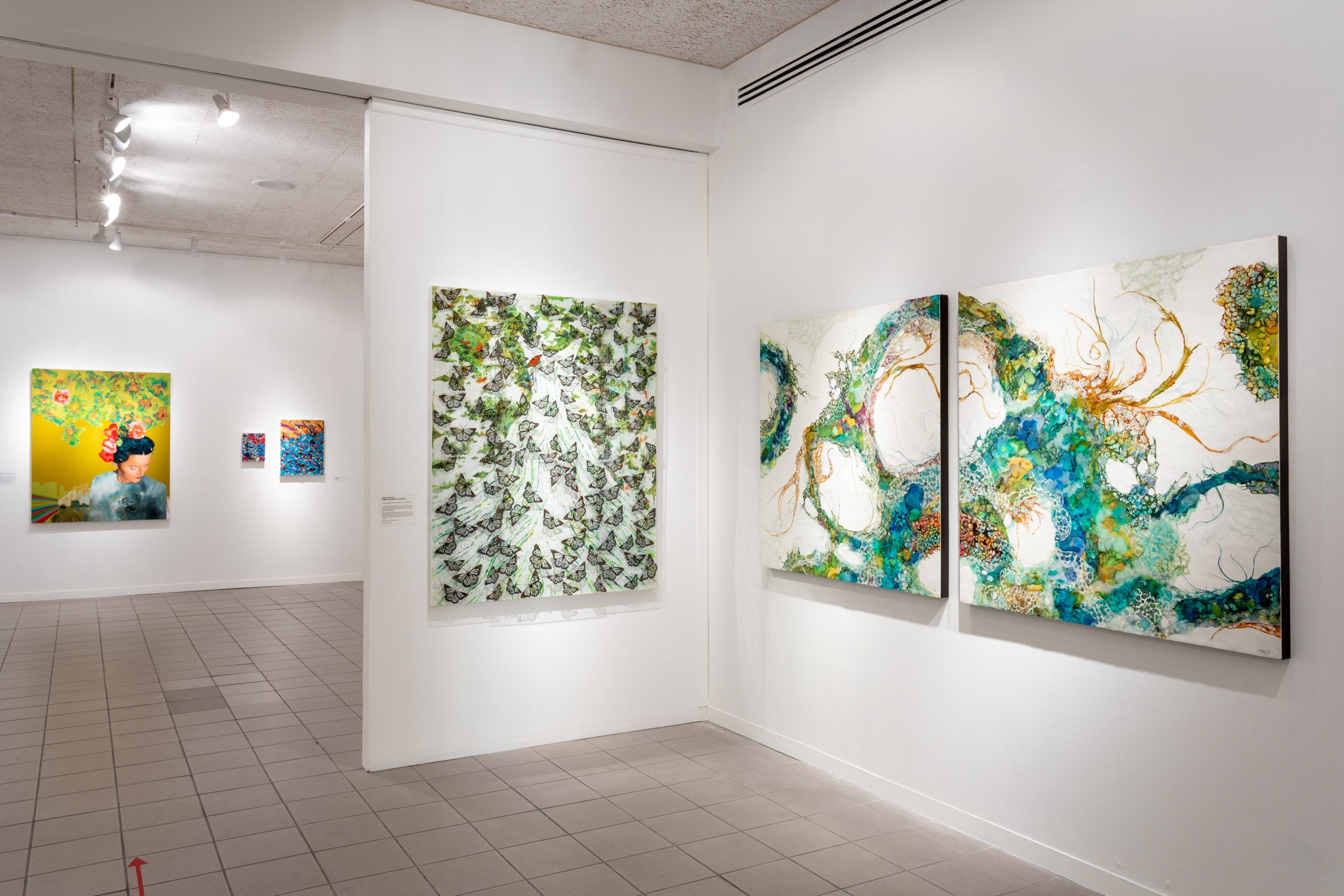
Center wall: Kathleen Kane-Murrell, La Ultima, mixed media, 60” x 48”
Right Wall: Maite Benito Agahnia, Amalgamation I and II, encaustic, ink, pigment and shellac on panel, 48” x 48”, both 2020.
These virtual platforms weren’t ideal to convey the meticulous details, lush textures and the scale of the art but it was what we had. We struggled a bit with technology and bandwidth but in the end we made it happen. The sessions also were cathartic; we had been shut-in and craved that human interaction. As we progressed through the year of production the group found ways to support each other through phone calls, video chats and virtual meet-ups. The artists had the gift of time undisturbed, to create.
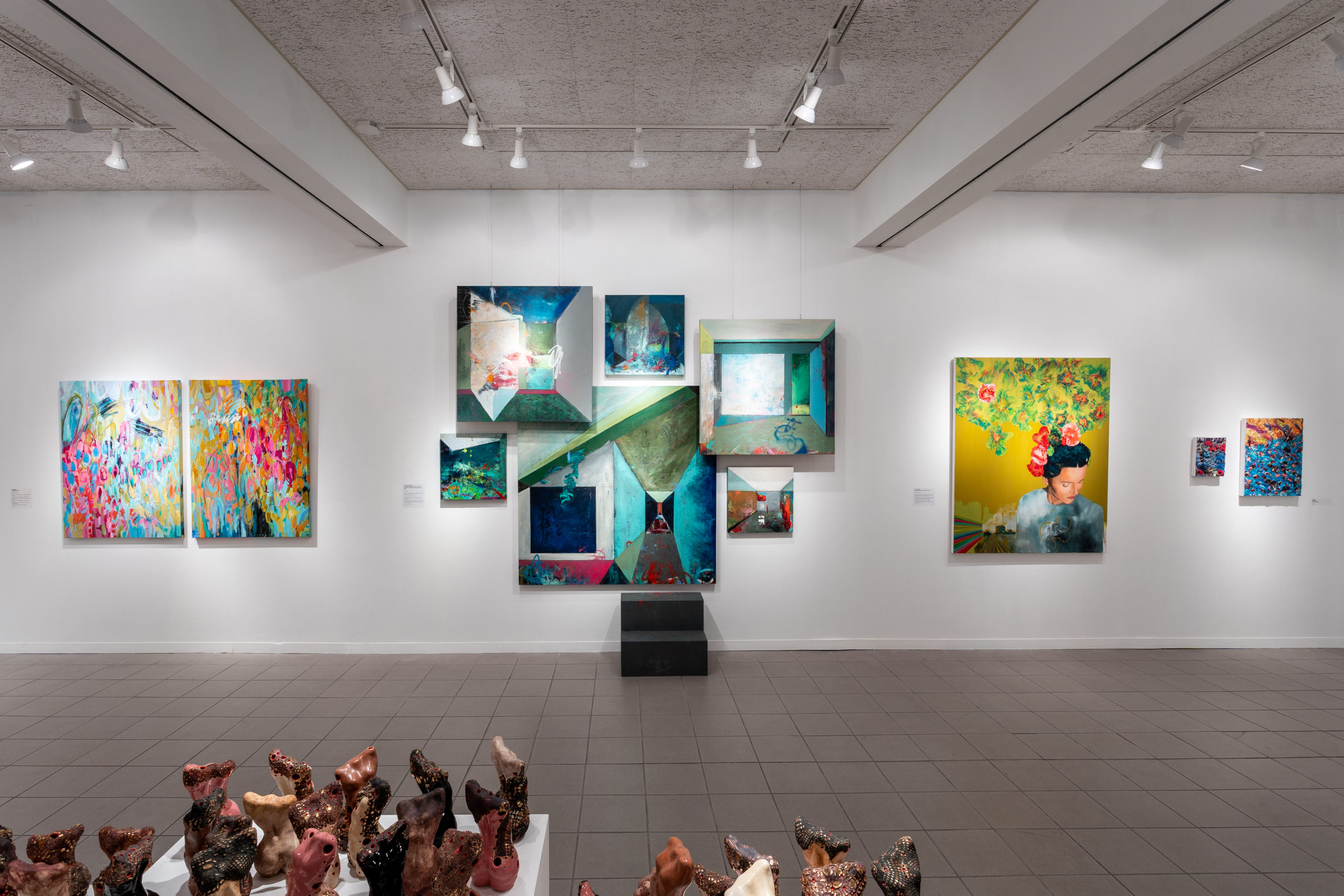
Left: Susan Darnall, Utopian Wings, mixed media on canvas, 48” x 72”.
Right: Theresa Vandenberg Donche, Rooms, mixed media on canvas, various sizes, both 2020
As we advanced into the late summer, the emotions of a many-sided national crisis began to shape the content in paintings, drawings, collages and sculptures. It was fascinating to see the ingenuity of approaches to what seemed to be the longest year of our lives. The pandemic motivated the artists to ponder on the vulnerability and the sacrifices made by families and community. The cries of George Floyd for his mother provoked them to confront racial injustice. If the art registered women’s struggles it also celebrated their power whether as leaders and activists or as mothers and essential workers.
The effects of climate change and political polarization also entered the visual conversation. The art also provided respite: a meditative respite, an expression of resilience.
Several overarching themes emerged during the artmaking process. Artists gravitated to topics that were relevant to them. Conversations with the artists flowed along these lines, I would offer suggestions and advice on how to present or advance the work. Julia C R Gray travailed on a series of ornamented ceramic cast torsos, She, the Power of Protest. She envisioned a large grouping as a testimony to the power of people coming together in protest as in the Women’s March or the BLM demonstrations. We were thinking of a number that would be meaningful and I mentioned that 2020 was the 55th anniversary of the Voting Rights Act and so she molded and glazed fifty plus pieces. Gray’s dogged perseverance also came through, as her three foot statue exploded more than once in the kiln during the firing process. The filled-in fissures became integral to the finished piece, they encoded the work with a resounding message of triumph over failure.
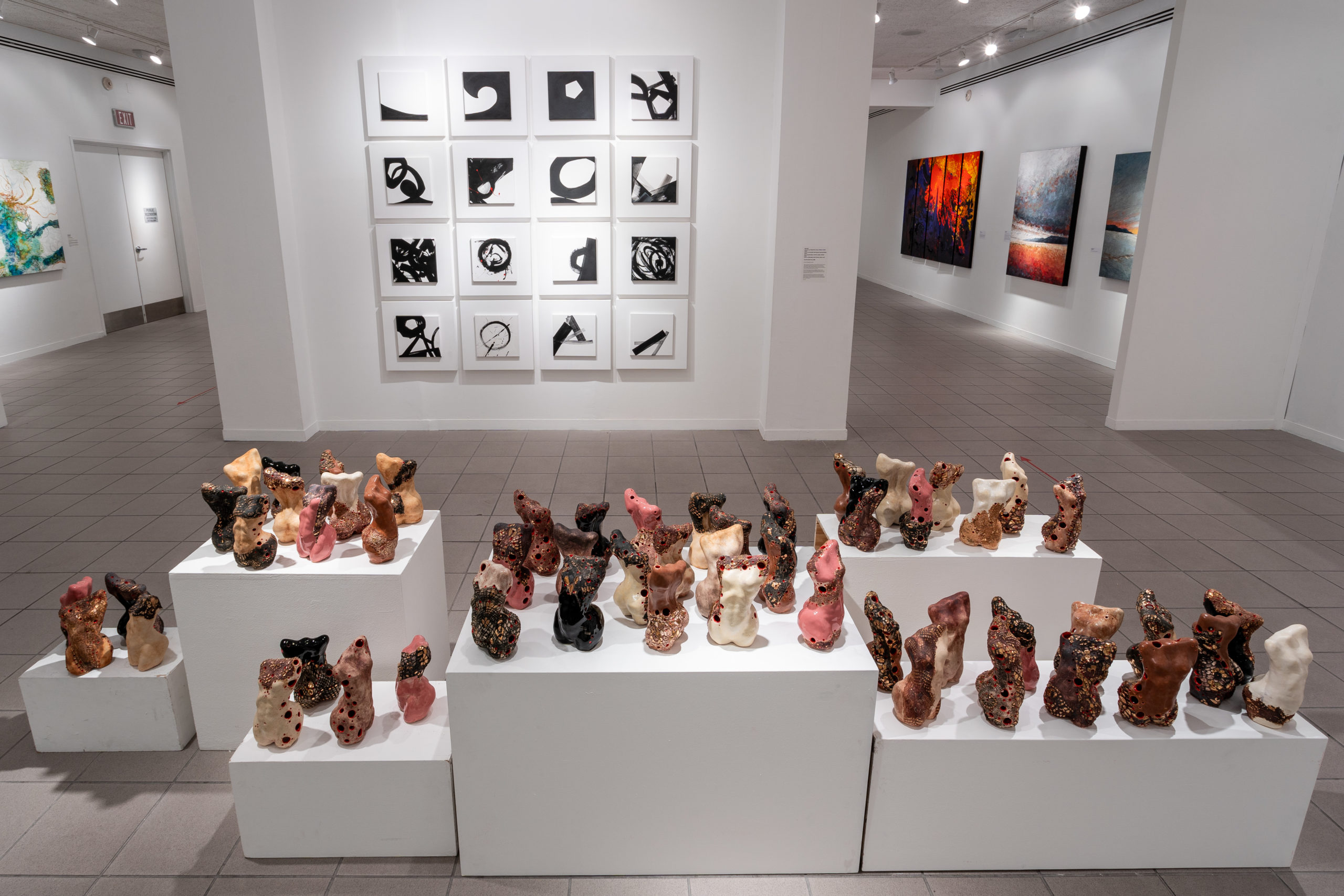
Foreground: Julia C R Gray, She, the Power of Protest, Installation 55, 2021, ceramics, 10” x 5.5” x 4. 25” each.
Background: Diane Hall installation, Sumi ink and acrylic on canvas, 20” x 20” each both 2020.
As Julia remembers: “the political NOW kept shifting under our feet. There were so many terrible events that we could not avoid because we had chosen to create artwork about what was happening in that very moment. Artists completely threw out their original ideas, they no longer felt relevant or as momentous as the horrors of the year, and none of the artists dodged the hard stuff.”
When I met with Gillian Moss we talked about her hometown of Belfast and where I had gone to visit family and to tour the political murals. Moss was not a stranger to social unrest, colonialism and bitter divisiveness. After discussing several ideas, I suggested she hone in a series of collages that expressed her outrage at the brutal murder of George Floyd. These struck a chord with me. The elegant mashups layered the up-and-down bar graphs of audio recordings of the words “breathe,” “humanity” and “stop” with organza silhouette cut-outs of her hands holding a phone as if capturing a picture or a video. Her mixed media works allude to an evidentiary recording that might lead to accountability such as in Darnella Frazier’s video of May 25th, 2020 that helped with the conviction of Chauvin. We discussed how 21st Century technology allows us to document incidents of abuse, but also to spread the message widely through social media.
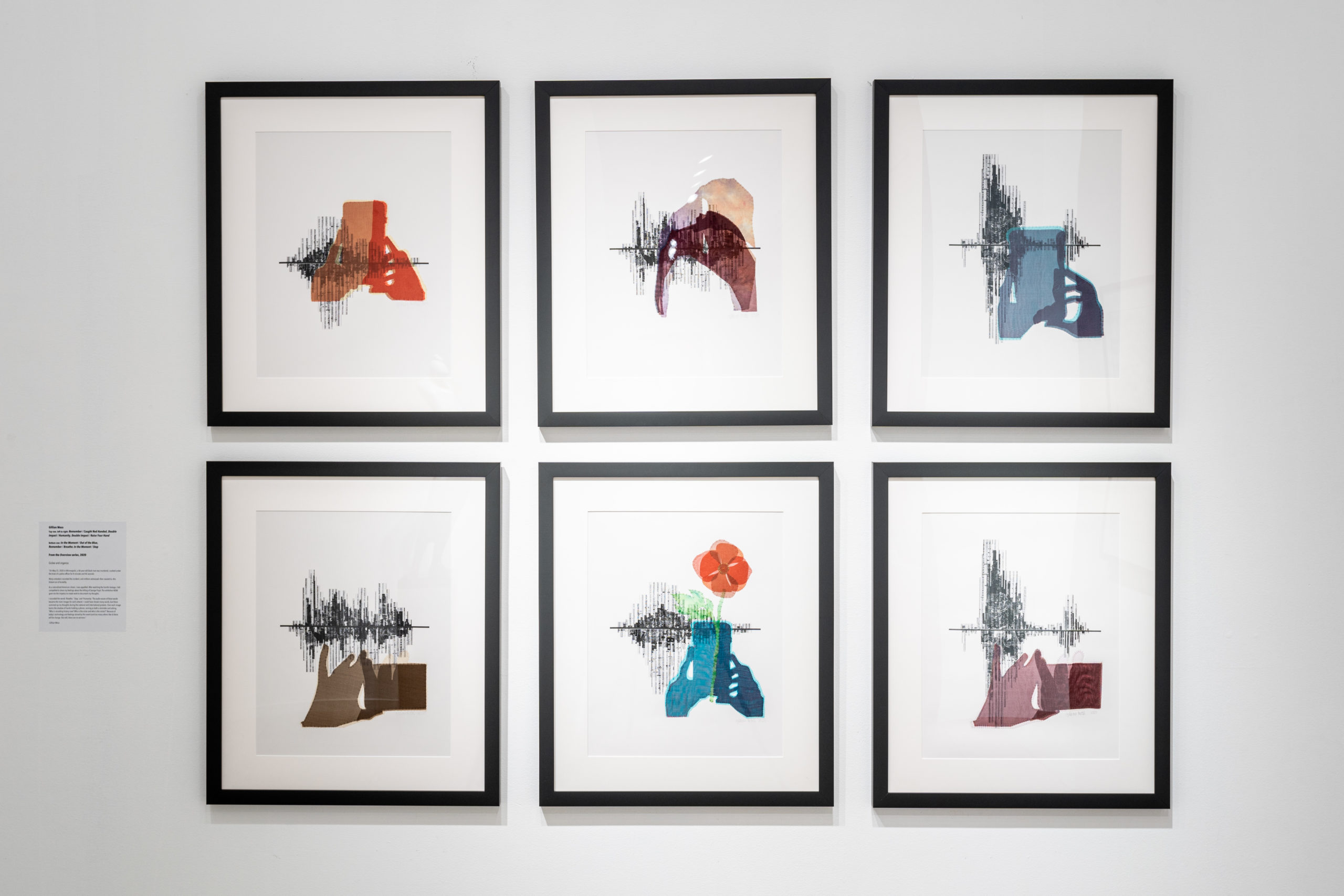
Gillian Moss
Top row left to right: Caught Red Handed, Double Impact, Out of the Blue
Bottom row, left to right: Raise your Hand, Remember, In the moment, all 2020, mixed media on artist card, 20” x 16” each
Lori Mitchell and Manuelita Brown also dealt with the trauma of racism in America as experienced by people of color. Mitchell’s delicate illustrations titled Best of Times, Worst of Times echo everyday joys and family events but lurking in darkened areas framed above these drawings the “Karens” and the evil hoods of the Klan make an appearance. George Floyd and his daughter are seen walking in the background of the panel Mama, I Can’t Breathe. Pencil marks fill additional black rectangles tabulating COVID deaths and getting more and more minute as the number of deaths rise exponentially. With raised fists, the marching figures in Brown’s sculpture Uphill Struggle which rise at the entrance to the galleries remind us of the significance of ordinary people fighting against prejudices and discrimination and being agents of change.
Lori Mitchell, Best of Times, Worst of Times (2020), left, Baby Girl and right Mama I Can’t Breathe,
watercolor, ink, charcoal, 40” x 20”
Some of my memories of our virtual dialogues imbued the works with personal significance beyond what the audience might perceive. Gail Titus If Not Now, When? conveys the urgent need for tearing out a system that has condoned police brutality. She deploys a curtain of lurid pigment like a blazing fire cutting through the night. There are delicately embroidered phrases embedded in the paint that call out for justice. The glow of orange and yellows cause a gut reaction, as I recall the devastation of the San Diego fires a few days before our meeting.
The power of the female voice weaves and wails through the exhibition. While trying to make sense of what was NOW, we experienced death, vulnerability, loss of innocence, and compassion. Women acted heroically: nurses, doctors, farmworkers, caregivers, mothers and daughters. Chatting through our laptops, Julia San Roman and I settled comfortably into a banter in Spanish, our native tongue. We shared stories of our experiences as immigrants, she came from Spain and I crossed from Mexico. To make a living, San Roman works as a medical interpreter and she is moved by her daily encounters with the patients for whom she translates. In her figurative paintings she lovingly renders their steadfast resolve to make it in this country. The patient/workers serve as her models and are celebrated in luminous canvases where they sit or stand next to elements from their trade, be it farm fields or industrial gears. Hardworking women framed by prismatic bands of colors and crowned with flowers that explode in painterly bouquets.
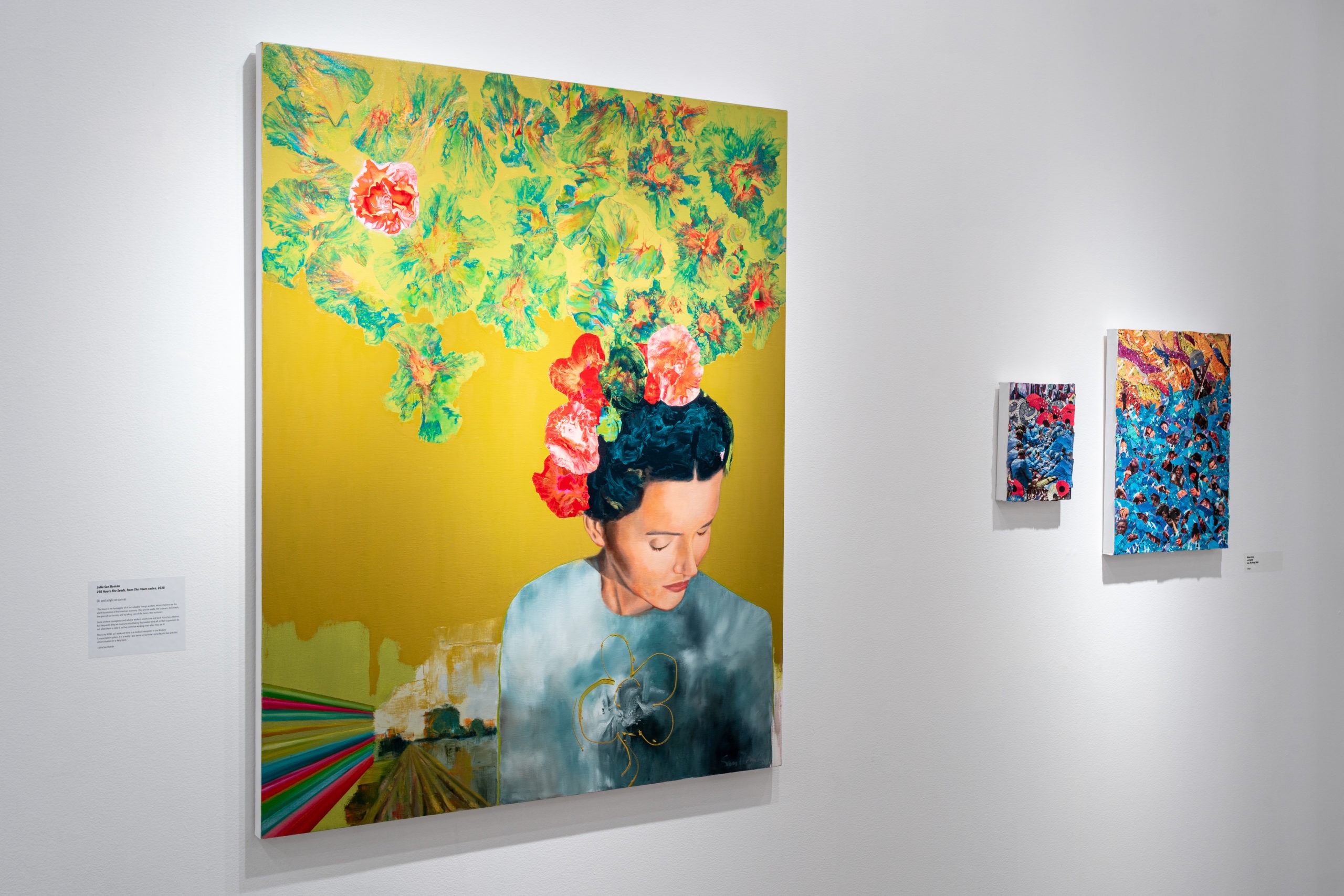
Left: Julia San Roman, 250 Hours, the Seeds, mixed media on canvas, 60” x 48”.
Right: Diana Carey, The Party, 12” x 9” and Riptide, 20” x 16”, All 2020.
Nature also made its appearance. It called out to artists like Kathleen Kane-Murrell who felt the pressing need to protect the earth and to reference the effects of global warming and climate change. The silhouette of a dress is a recurring trope in her work as a call for women nurturers to take charge. In La Ultima a lone Monarch floats in the midst of ghostly butterflies pointing at their dwindling numbers suggesting a tragic future if we remain passive. Anxieties also transformed into views of gardens or sunsets and sunrises. Susan Darnall’s florid Utopian Wings make me think of the hikes that kept me sane while Alison Hailey Paul’s darkened skies and landscapes mark the passing of time, the much needed Renewal and Awakening.
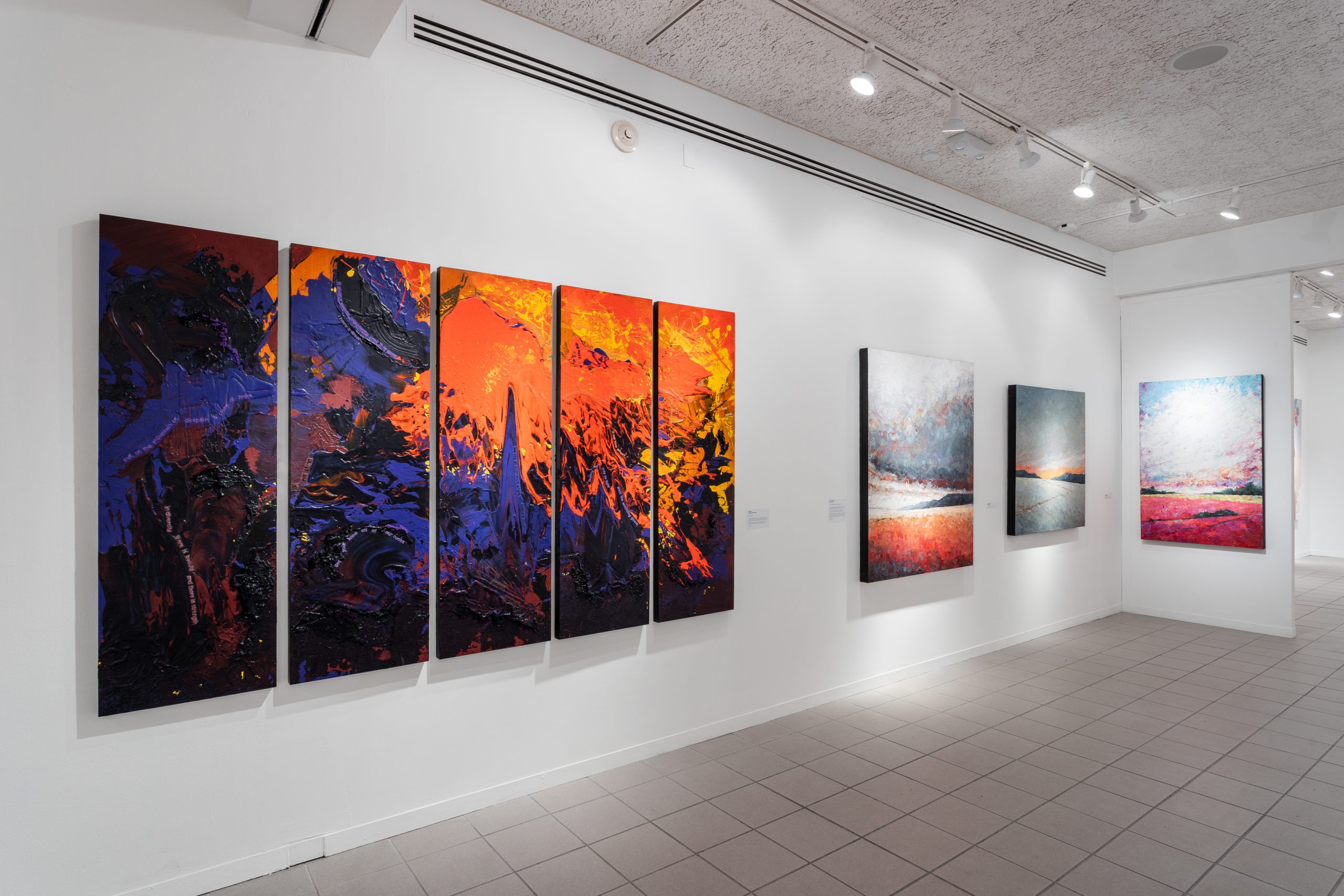
Left: Gail Titus, If Not Now, When? (2020) acrylic and fiber, 65” x 105”.
Middle and right: Alison Paul, Renewal (2020), 60” x 48”, Awakening (2019),
48” x 48” and Delight (2018) mixed media on canvas. 60” x 36”
In the end this exhibition with its multiple genres and approaches bears witness to the power of art and how something positive can be borne out of the darkest situation. 2020 forced us to hold onto the joyful moments: a walk by the beach, the songs of the birds, the embrace that waited until we were vaccinated. The artwork of TWA: NOW will prompt visitors to re-examine their own memories of this fateful year and it is emblematic of hope as put forth through creativity.
Twenty Women Artists: NOW is on view at Oceanside Museum of Art in Oceanside, California, through August 1. For more information go to the exhibition page.
All photos courtesy of Oceanside Museum of Art.
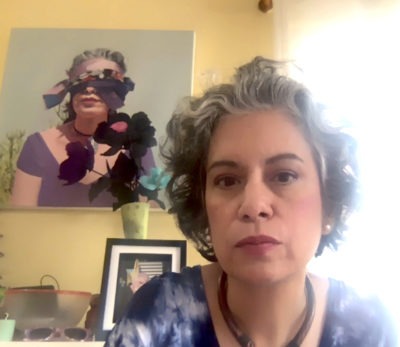 Alessandra Moctezuma is Gallery Director and Professor of Art at San Diego Mesa College, where she leads the Museum Studies program and teaches Chicano Art. She earned Bachelor of Art and Master of Fine Arts (Painting/Printmaking) degrees from UCLA. Besides teaching and curating, Ms. Moctezuma has been actively involved in the San Diego arts community. She’s on the board of the Women’s Museum of California, Medium Photography, The Friends of the Villa Montezuma.
Alessandra Moctezuma is Gallery Director and Professor of Art at San Diego Mesa College, where she leads the Museum Studies program and teaches Chicano Art. She earned Bachelor of Art and Master of Fine Arts (Painting/Printmaking) degrees from UCLA. Besides teaching and curating, Ms. Moctezuma has been actively involved in the San Diego arts community. She’s on the board of the Women’s Museum of California, Medium Photography, The Friends of the Villa Montezuma.
Please visit: San Diego Mesa College Galleries.
Photo: Zoom Selfie, Alessandra Moctezuma, 2020
The MAHB Blog is a venture of the Millennium Alliance for Humanity and the Biosphere. Questions should be directed to joan@mahbonline.org
This article is part of the MAHB Arts Community‘s “Covid19 Diaries Series”. If you are an artist interested in sharing your thoughts and artwork, as it relates to the disrupted but defining period of time we live in, please contact Michele Guieu, Eco-Artist, MAHB Member, and MAHB Arts Community coordinator: michele@mahbonline.org.
Thank you. ~

